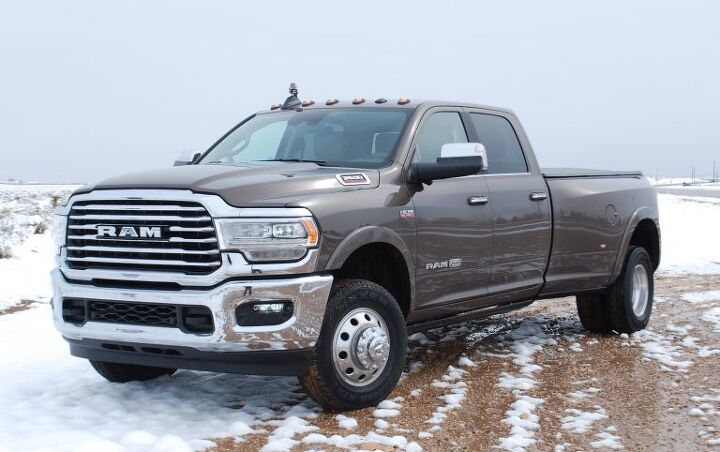Full-size Truck War Update: Ram Fills Ford's Rear-view in 2019

With full-year sales stats now available from each of the Detroit Three, we can see how the leaders in the critically important full-size pickup segment faired in the eventful year of 2019.
And it was an eventful year, what with new full-sizers on offer from Ram, Chevrolet, and GMC, and revamped Heavy Dutys from both Ram and GM entering the fray. (GM’s big guys landed for the 2020 model year, with Ford’s redesigned 2020 Super Duty series arriving shortly after the launch of its Detroit rival.)
It’s no secret that Ram did well last year, but how did it stack up next to the perennial front-runner?
New introductions skew the sales picture somewhat, what with production gaps and sell-downs of old stock, not to mention periods of non-availability of certain build configurations. That said, Ram has reason to smile, posting an 18 percent sales gain for the year. That figure covers the old 1500 Classic, the new-for-2019 1500, and the updated HD.
Yes, keeping the old-generation half-ton in production alongside its newer sibling did wonders for Ram volume in 2019, and the much-improved (and well-received) new generation didn’t hurt it, either. Total production of all Ram-badged trucks amounted to 633,694 vehicles, outselling the Chrysler, Dodge, Fiat, and Alfa Romeo brands combined.
That total brought the brand closer than ever to Ford’s famed F-Series, which sank 1.4 percent for the year, ending 2019 with 896,526 units sold. Last year’s F-Series decline was the first dip since 2014, when Ford was in the process of switching to the aluminum-bodied, 13th-gen F-150 model. The folks in Dearborn no doubt anticipate greater things in the current year, what with the powerful new Super Duty now online and a new F-150 appearing later in the year.
Ram’s climb over the past decade (and out of the recession) is worthy of note. In the dismal year of 2009, the newly created brand sold just over 177,000 trucks, pushing past the 300,000 barrier in 2013, the 400,000 barrier the following year, and the 500,000 barrier in 2017.
It also pushed past Chevrolet and its Silverado line of full-size and HD pickups, relegating its bowtie rival to an ever firmer third place. In the ramp-up and transition year of 2019, Silverado volume fell 1.7 percent to 575,600 vehicles. Its GM stablemate, GMC, saw its full-size pickup volume rise 5.2 percent to 232,323 units. Together, the two marques still outsell Ram, but in terms of individual brands, Ram is solidly second.
It remains to be seen whether Chevrolet, whose big truck volume topped 600,000 in 2015, will narrow the gap between it and Ram in the current year. No longer does GM build the old versions of its full-size pickups, while Ram brass seem perfectly happy to keep the 1500 Classic alive for as long as needed. There’s cash on the table for its continued production.
Elsewhere in the full-size truck realm, two afterthoughts lingered well behind the Detroit pack in 2019 — a place they’ve grown accustomed to inhabiting. Toyota’s ancient Tundra sank 5.6 percent last year, while Nissan’s Titan and Titan XD — refreshed for 2020 — declined by a whopping 37.5 percent. Total Titan volume last year represents about two week’s worth of F-Series sales.
[Images: Fiat Chrysler Automobiles, Ford, General Motors]

More by Steph Willems
Latest Car Reviews
Read moreLatest Product Reviews
Read moreRecent Comments
- Mike Beranek A driver's seat that delivers a 10,000 volt shock whenever the driver makes a turn or changes lanes without signalling.
- Wolfwagen How about some standardization of wiper controls? I have 5 different cars in my family's fleet and have driven a ton of rentals for work. Holy F*cking Sh*t Balls! Left side, right side, push the lever up to turn on, push the lever down to turn on, push the lever forward to turn on, pull the lever back to turn, slide indicator to the left to decrease intermittent wipe time, slide indicator to the right to decrease intermittent wiper time.
- Redapple2 Someone else said it. Looks like a 4/5 size ford edge (front and back)
- Rochester Tim, where was your head at in 1984 when it became a law to wear your seatbelt? Personally I thought it was none of the Gubmint's bizniss to force me to belt up. Today, I feel exposed and unsafe without it. My point is, give it time, both the tech and your values will evolve.
- Theflyersfan After looking it over, Honda, I want royalties for this one: The Honda Yawn.




































Comments
Join the conversation
I have always been a Ford and GM truck owner until I drove my brothers 2019 Ram 1500. The smooth quite ride and unreal interior gave me the new truck bug. I ordered a Laramie 5.7 with eTorque. I got 25.5 mpg on a road trip through Louisiana. If you are considering a new truck test drive the Ram. Your in for a surprise.
The sales numbers seem to show ugly counts even for GM loyalists which I assume is why you see the bump in Sierra as some just can't plop down money on the silverado. I must admit the 6.2 and the new inline six duramax are reasons to at least look at GM thou, curious how the little duramax holds up the babyh in the Colorado seems to be holding up OK compared to the VM in the ram ecodiesel, haven't heard much on Fords baby diesel.